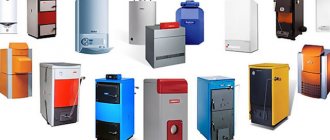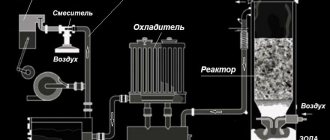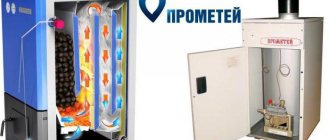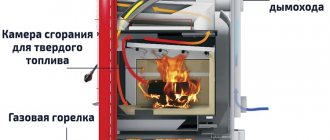Pros and cons of boiler operation on propane cylinders
- The need to control the fullness of the cylinders. For normal operation of a gas boiler, 3-4 gas cylinders are needed. Tracking exactly when the gas runs out without additional equipment is quite problematic. If permanent operation of the system is planned, it is better to spend money and connect the boiler to several cylinders through a ramp and a reducer.
- Gas cost - in comparison with the main connection, the cost of heating LPG is slightly higher, but less than when using an electric boiler.
- Features when connected to a propane tank. According to the PB, it will be necessary to take the containers to another ventilated room or to the street, which is not always convenient. It is necessary to purchase separately a device for connecting at least four gas cylinders to the boiler, as well as control and monitoring fittings.
- Conversion - not all boilers can be converted to LPG with the same efficiency. Replacing the burner will cost about 30-40% of the total cost of the boiler.
- The need to attract qualified specialists. Only a licensed specialist can connect several propane cylinders into a single network, change the burner and make the connection correctly.
Annual temperature cycle
If we talk about the central part of Russia and the northwest, the average January temperature is -8 ° C, peak temperatures in winter reach -35 ... -40 ° C. Similar indicators of minimum temperatures, although at a higher average January temperature, are typical for the southern district. In the Urals and Siberia, these indicators are even lower (-45 ... -58 ° C).
Naturally, these indicators differ significantly from those of European countries. The table shows a few examples:
| The country | Average January temperature, ºС | Min temperature, ºС |
| Germany | + 1 | -10… -15 |
| France | + 2 | -5… -10 |
| Italy | + 3 | -12* |
* temperature in the subalpine zone
Naturally, the equipment manufactured in these countries is focused on the use in these temperature ranges.
First of all, this concerns the projected capacity of the boiler house. Another climatic zone, the difference in insulation standards and norms for the thermal conductivity of structures (windows, frames, walls) in Russia and Europe - all this must be taken into account when determining the boiler power.
Lower ambient temperatures not only require a significant power reserve, but also lead to more intensive equipment operation, high fuel consumption, higher wear, and increase the requirements for the reliability and efficiency of the boiler.
The second important factor is the impossibility of using antifreeze liquid as a heat carrier in boiler houses of most European manufacturers.
Boilers made in Europe are originally designed for operation in warmer climates and use water as a heat carrier, which provides better heat removal than an anti-freeze liquid.
When non-freezing liquid is used in such boilers, a small but constant overheating occurs, which leads to the failure of the heat exchanger. Most European manufacturers do not carry out warranty repairs of boilers when using non-freezing liquid as a heat carrier.
When the heating system stops due to a drop in gas pressure or other reasons and its "defrosting", the use of water as a heat carrier leads to rupture of pipelines, which is fraught with significant costs for repairing not only the heating system but also the entire house.
Unfortunately, the products of very few manufacturers are designed to use antifreeze liquid as a heat carrier. These are the Scandinavian countries - Finland, Sweden.
Advantages and disadvantages of units
Liquefied gas boilers are cheaper than appliances that use other types of resource. Among the advantages of the equipment are such parameters as:
- complete independence from centralized fuel supplies and regular price increases for utility services;
- high level of efficiency (on average 92-95% and up to 97% for some models);
- quiet burner (for comparison, the burner of a diesel boiler produces a noise effect of 60-75 dB);
- the equipment does not require time-consuming and expensive maintenance, replacement of the fuel filter and nozzle, reconfiguring the burner and cleaning the heat exchanger;
- complete autonomy of the system and, as a result, the absence of emergency situations;
- unpretentiousness of devices with good reliability;
- the possibility in the future not to buy a new boiler, but to transfer the existing one to the main gas;
- long service life of units (floor-mounted - up to 25 years, wall-mounted - 15-20 years), subject to qualified installation, compliance with operating rules and timely service;
- safety of devices running on liquefied gas (fuel does not ignite even when the container it contains is heated. Combustion occurs only at the moment of mixing of the substance and oxygen, and this happens directly in the burner and only in it).
There are completely non-volatile products on sale that allow you to organize a complete heating system in hard-to-reach conditions, for example, in a remote forest area or high in the mountains.
Of the minuses of devices, the following positions are most significant:
the need for constant high-quality work to connect the boiler to 3-4 propane cylinders by means of a reducer and a ramp; it is undesirable to place containers with liquefied gas near the boiler
It is better to place them in nearby rooms equipped with a good ventilation system, or take them outside and mount them in a special box; the care and caution required when connecting the cylinder, since all operations are performed manually and require the use of physical force; the subsequent re-equipment of some models of boilers for ordinary gas is expensive (replacement of the burner costs 30-40% of the total price of the boiler); installation of the unit and connection to gas supply communications should be done by a licensed specialist with work experience .. The ratio of pros and cons must be considered in each individual case and, based on the conclusions made, make a decision on the advisability of buying one or another type of equipment
The ratio of pros and cons must be considered in each individual case and, based on the conclusions made, make a decision on the advisability of purchasing one or another type of equipment.
Conversion of the boiler house to liquefied gas
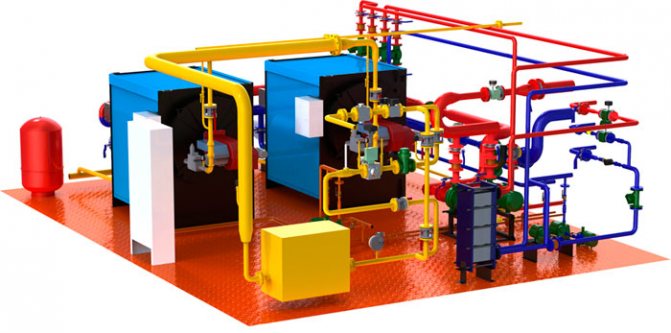
Liquefied gas boilers are a good option for heating an object, if there is no way to connect to the main gas pipeline. When using liquefied gas, the cost of heat energy is lower than, for example, in diesel systems. But the conversion of the boiler house to liquefied gas is quite labor-intensive and expensive. The most difficult thing is to add a gas tank, which will ensure the operation of the boiler house.
A gas holder is a special tank where natural or liquefied gas is stored. There are gas tanks of variable and constant size. An alternative to a gas tank is the use of gas cylinders. This is a good replacement, only you should worry about their delivery in advance and allocate storage space to ensure the smooth operation of the heating system.For heating small rooms, this is an ideal alternative, since the installation of a gas tank and its maintenance incur additional material costs.
The advantage of diesel boilers is that with the subsequent gasification of the facility, the cost of re-equipping the boiler room will be minimal.
Read about what the consumption of a diesel boiler can be here.
Such boiler rooms cannot be located in basements. In the basement floors, their placement is permissible, but subject to strict observance of technical requirements, in the presence of window openings, with an area of at least 1 m2.
How to convert a boiler to liquefied gas
Theoretically, it is not difficult to reconfigure the heat generator, the main thing is to replace the nozzles responsible for the gas consumption in the boiler. After that, it is necessary to adjust the gas valve in accordance with the operating instructions. Plus the controller setting in the case when the unit is automated. For a good specialist with tools and equipment for everything, half an hour is the maximum.
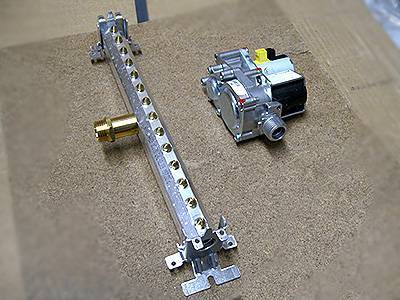

The instructions for the product may include a section for service technicians, where everything is described in detail. But you need to have a pressure gauge to adjust the gas pressure. The first thing to do is change the jets on the burner ramp. To do this, you need to remove the front panel or open it. Further, the ignition group is unscrewed and removed, followed by the ramp. Jets are screwed in from its inner side, which should be replaced.
Further adjustments are made using a pressure gauge. You should be aware that the use of liquefied gas in gas boilers requires adjusting the pressure in the line leading from the automatic valve to the burner. Having carefully studied the instructions, you need to find the appropriate fitting and put on the hose from the pressure gauge, and then, starting the heat generator, regulate the minimum and maximum gas pressure with a special valve. How to perform this operation on the BAXI Eco Compact boiler is shown in detail in the video:
Gas veins - how does gas circulate through the system?
Before gas turns into a blue flame on your stove, it travels hundreds and thousands of kilometers through gas pipelines. The most important artery of the gas transmission system is the gas pipeline. The pressure in such lines is very high - 11.8 MPa, and is completely unsuitable for private consumption.
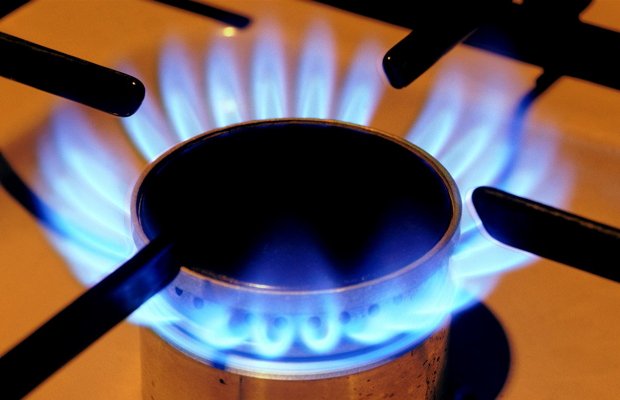

Blue flame of gas on a kitchen stove
However, already in gas distribution stations (GDS), the pressure drops to 1.2 MPa. In addition, at the stations, additional gas purification takes place, a specific smell is given to it, which is perceptible to the human sense of smell. Without odorization - this is the name of this process - we would not feel the presence of gas in the air when it leaks, since methane itself has neither color nor smell. Ethanethiol is often used to impart a smell - even if there is one part of this substance in the air for several tens of millions of parts of the air, we will feel its presence.
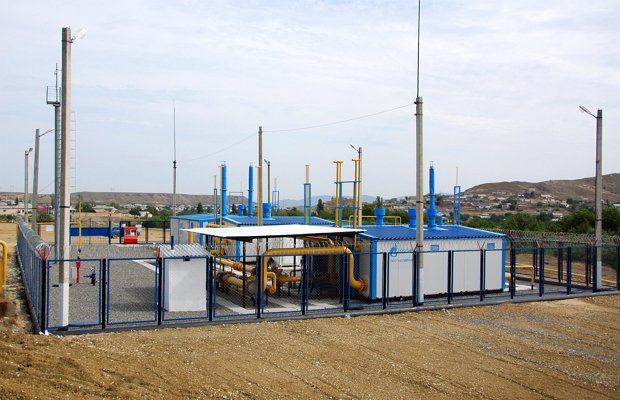

Gas distribution station
From the gas distribution stations, the gas route runs to the gas control points (GRP). These points are, in fact, the point of distribution of blue fuel between consumers. At hydraulic fracturing, automatic equipment monitors the pressure and recognizes the need to increase or decrease it. Also, at gas control points, another stage of gas filtration takes place, and special devices record the degree of its contamination before and after cleaning.
Gas system organization
For the correct organization of the gas system, the gas consumption is calculated. Gas consumption is calculated based on the heated area. The number of cylinders is calculated from the volume of gas consumed. But not more than 6 pieces. in one system. The bladder system is connected by means of a ramp, which ensures a safe and stable gas supply to the gas boiler.
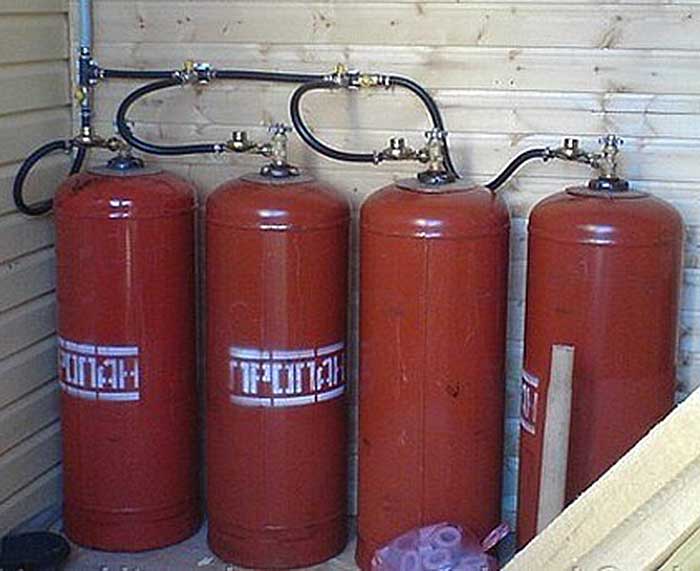

The balloon system is located in a metal cabinet at a distance of at least 0.5 m from the house. Ventilation holes are drilled at the top and bottom of the cabinet. The cabinet must be freely accessible. It is recommended to place a cabinet with a balloon system on the north side of the house.


Types and characteristics of liquefied gas
Natural gas was used to heat the premises; difficulties with its storage prompted the invention of liquefied gas. It is a mixture of propane and butane. It is more convenient to store and transport liquefied gas.
The advantage of liquefied gas
- Technically not difficult and not costly production of a gas mixture.
- The gas mixture is environmentally friendly due to low-contaminated waste materials.
Disadvantages of propane butane mixture
- refueling cylinders for refueling, there is a possibility of refueling with poor quality gas;
- cylinders are changed manually;
- the liquefied gas mixture is explosive, safety precautions must be observed;
- in order for the mixture to burn completely, the storage location of the cylinders is ensured by proper ventilation.
Features of the choice of a bottled gas boiler
Houses are heated with three types of gas cylinders:
- Single-circuit boiler.
- Double-circuit boiler.
- Condensing boiler.
A single-circuit boiler is manufactured with a closed combustion chamber. The boiler flame is enriched with oxygen inside the room. Waste materials are discharged outside through the chimney.
A single-circuit boiler is designed for space heating. Such boilers are installed if the problem with hot water is solved.
Double-circuit boilers are designed for heating and hot water supply at home. The operation of the heater is due to the operation of 2 burners. They are ignited using an igniter with built-in piezoelectric elements. After ignition of the igniter, a temperature sensor is included in the process, which is triggered when a certain temperature is reached and closes the combustion chamber. Waste materials are discharged to the outside through a chimney or ventilation. Double-circuit gas boilers operating on bottled gas are a convenient option for solving the problem of heating and supplying hot water.
The condensing boiler supplies the house with heat and hot water. Cold water entering the heat exchanger is heated by a burner and hot air. After this procedure, part of the water goes to heating the house, the other part of the water is used for household needs. After going through a full cycle, the water from the radiator returns to the heat exchanger.
The bottled gas condensing boiler is available in two types:
- floor version of the boiler;
- wall-mounted version of the boiler.
Waste gas products are discharged through the flue to the outside.
Winter fuel and gas pressure
Let's consider the specifics of the operation of boilers of European manufacturers on liquid fuel and natural gas.
Similarly to the impossibility of using antifreeze liquid, it is impossible to use "winter" diesel fuel (containing additional "additives") in boiler houses of most European manufacturers, which creates problems with the operation of liquid fuel boilers.
Normal gas pressure in the network in Europe is 20 mbar. It is for this pressure that the equipment of European manufacturers is designed. Of course, they are trying to "adapt" them for Russia by reprogramming the automation, but in reality this leads to a drop in power and efficiency and does not save with a large drop in pressure.
At the same time, the normal gas pressure in the northern countries - the USA, Canada, Russia, Sweden - is significantly lower - 13 mbar. At the same time, the real pressure in Russian gas networks can be 5-7 mbar.
In practice, this leads to malfunctions and possible shutdown of European boilers that are not designed for such pressures.
During cold weather, the gas pressure in the network decreases, and consumption increases.This problem is most critical on the "dead-end" branches of the gas network (which often connect the cottage villages).
With a reduced gas pressure, a decrease in the boiler power occurs (for example, a boiler with a rated power, for example, 50 kW, often operates only to 2/3 of its capabilities and is ready to heat an area of only about 300 m2).
In the event of a strong drop in pressure, the boiler can be shut down. The minimum working pressure is individual for different systems, which must be taken into account when choosing equipment. It is almost impossible to avoid stopping the boiler; the solution to the problem can be the use of a backup circuit and multi-fuel systems. When the boiler stops due to a drop in gas pressure, it becomes critical to use an anti-freeze liquid in the system, which will avoid damage to the system.
How to connect a LPG gas cylinder
Installing a gas boiler designed for autonomous heating with bottled gas is much easier than installing a heating system using mains fuel.
In view of this, self-installation of this unit is not recommended. It is better to invite a responsible specialist. The norms and rules for the correct installation of the cylinder are regulated by the set of requirements of the industrial safety code, which states that cylinders with liquefied gas should not be located in the same room as the heater.


Besides:
- The cylinders must be taken out into an adjacent room or outside and installed in a special cabinet.
- Storage of empty gas cylinders must be ensured outside the building. It is best if you refuel the containers immediately.
- If the cylinders that you installed in the closet on the street freeze, you should insulate the storage with non-combustible thermal insulation.
- It is strictly forbidden to heat containers or the cabinet itself with an open fire.
- The distance between the gas cylinder and the boiler must be at least 2 m.
- Do not store propane cylinders near the boiler room.
- It is allowed to store containers only in a specially equipped place located at a distance of at least 10 meters. Ventilation must function in it.
- It is also prohibited to use the basement for this purpose.
During the operation of the cylinders, complete depletion of the LPG from the tank is not allowed. Every 4 years, it is necessary to carry out certification of the tightness of the containers and the integrity of their body.
Low or medium - which pressure is better?
Previously, most residential buildings were supplied with a low-pressure gas pipeline (0.003 MPa), since a medium-pressure pipeline (0.3 MPa) requires more extensive installation work and the purchase of special equipment that reduces the pressure directly at the gas inlet to the pipes inside the house.
However, with an increase in the number of consumers in a low-pressure gas pipeline, there may simply not be enough fuel for everyone - this becomes especially noticeable in winter, when most of them turn on gas boilers at full capacity. In a medium pressure system, this problem is virtually eliminated. The high requirements of modern gas boilers should also be taken into account. With insufficient pressure, many units, at best, produce less power than indicated by the manufacturer, and in the worst case, they turn off until the required pressure appears in the system.


Modern gas boilers
Buying expensive boilers for low-pressure consumers is like throwing money down the drain, since such a purchase will not justify itself at all. It is up to consumers to solve the problem of gas interruptions. Alternatively, you can purchase a combined solid fuel boiler, which can be loaded with solid fuel during the absence or too low gas pressure. In the kitchen, you can use a liquefied gas cylinder by setting one burner for this type of fuel.
With increased pressure, the situation is no better - if no distribution devices are installed in the houses, the risk of emergencies increases. Since low pressure gas is considered safer, its use is prescribed in public institutions such as schools, kindergartens, hospitals, as well as factories and enterprises of various types, where gas is used for heating purposes. Also, gas pipelines with low rates are laid to small settlements.
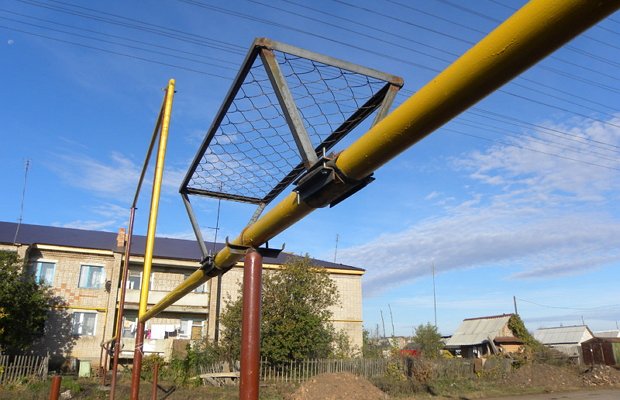

Gas main in a small village
In large cities with a high social status, a high pressure gas pipeline is being laid. This decision is made based not only on the number of consumers, but also on their financial ability to pay for the purchase of more expensive and powerful equipment. By and large, consumers do not choose which gas pipeline to use, unless only when choosing a place of residence.
How to calculate the volume of gas for heating a building
To build a high-quality and reliable heating system, where the main heating element is a propane boiler, you must have the following list of building materials:
- directly the boiler;
- fittings for fasteners;
- gasholder (container used for storing gas);
- hoses that are responsible for connecting functional elements;
- an ordinary shovel.
The gas boiler is installed in a special room, which plays the role of a fuel storage. Naturally, all work that is carried out here must be carried out in strict accordance with safety regulations. Installing a gas tank is a prerequisite, since the fuel consumption when using cylinders is very high. It is necessary to install this container in the ground, but it is also possible to install it on a surface not far from the equipment itself.
Despite the delusion of some owners of private houses about the uselessness of a gas tank, its installation when installing a gas boiler has a number of advantages:
- absolutely no gas smell will be felt;
- due to the large volume, it is extremely rare to replenish the gas tank reserves (approximately twice per heating season);
- the possible danger of a gas explosion is absolutely excluded.
To calculate the amount of gas that is needed to heat a particular house, you need to remember that 0.1 liters. this fuel produces 1kW of heat energy. In any case, this value may differ in a certain direction - it depends on the performance of the boiler and its device. In addition, factors such as the climatic conditions of a certain area, as well as the installation of thermal insulation in the house, also have an impact.
Another important question is how often it is necessary to replenish gas reserves in the storage facility. As an example, we will use as a basis a container, the volume of which is 5 cubic meters. The maximum filling of this tank is approximately 4200 liters, which equals 2200 kg of gas.
Using the formula, you can calculate how much fuel will be consumed per hour of boiler operation: 0.1kgx20kW / 2 = 1kg. Dividing 2200 kg by 1 kg / h, you can calculate that the volume of this container is 5 cubic meters. enough for heating for 2200 hours, this is 95 days. Naturally, one cannot but say that propane is much cheaper, in contrast to electricity, and is more economical.
Classification of natural gas by pressure
← previous articleConversion of units of measurement 1 kW, 1 kcal / h, 1 MJ / h, 1 kWh, 1 kPa, 1 atm, 1 mbar Tables of units of measurement of power and pressure measurement - converting from one system to another ... .next article → Chemical analysis of water for determination of the chemical water treatment system in the boiler room Water analysis for chemical water treatment, Calcium, Magnesium, Fluorine, Turbidity, Microbes mg / dm3 (l). Standards of the norm. An example of a study by Vodokanal of chemical indicators of water to determine a chemical water treatment system in a boiler house TKU-1.24 MW (Ivanovo)….
Author: Alliansteplo
Date: 07/31/2014
| Low gas pressure | Average gas pressure | High gas pressure category II | High gas pressure category I | |
| 1 MPa | up to 0.005 | from 0.005 to 0.3 | from 0.3 to 0.6 | 0.6 to 1.2 |
| 1 kPa | up to 5 | from 5 to 300 | from 300 to 600 | from 600 to 1200 |
| 1 mbar | up to 50 | from 50 to 3000 | from 3000 to 6000 | from 6000 to 12000 |
| 1 bar | up to 0.05 | from 0.05 to 3 | from 3 to 6 | from 6 to 12 |
| 1 atm | up to 0.049 | 0.049 to 2.960 | 2.960 to 5.921 | 5.921 to 11.843 |
| 1 kgf / cm2 | up to 0.050 | 0.050 to 3.059 | from 3.059 to 6.118 | 6.118 to 12.236 |
| 1 n / m2 (Pa) | up to 5000 | from 5000 to 300000 | from 300,000 to 600,000 | from 600,000 to 1,200,000 |
| 1 mm. water Art. | up to 509.858 | from 509.585 to 30591.48 | from 30591.48 to 61182.96 | from 61,182.96 to 122,365.92 |
Gas pipeline
Is the backbone of gas networks. It is customary to classify gas pipelines by pressure:
- low pressure gas pipelines
serve to supply heating to ordinary citizens, small gas boiler houses, medium-sized enterprises; gas pressure in them is up to 5 kPa; - medium pressure gas pipelines
up to 0.3MPa; - high pressure gas pipelines
up to 1.2 MPa, which, in turn, are subdivided into categories I, II and III.
While low pressure gas pipelines are used to operate in small gas boiler houses, medium and high pressure gas pipelines provide heat and hot water supply to various utilities and industrial enterprises. They usually work through gas control units.
Gas supply is carried out using different systems, multistage and single-stage. Usually, in small settlements, preference is given to a two-stage gas pipeline, and in large cities, for the most part, multistage high-pressure gas pipelines are used. Very large gas consumers have the opportunity to connect to the CHPP using a gas control unit or directly to the mains.
In addition, gas pipelines of different pressures are divided into onshore (or flooded) and underground (or underwater).
To calculate the cost of the boiler room, please fill out the questionnaire for the boiler room. The questionnaire can be completed online or downloaded. For any questions you may have: multichannel phone email
Fill out the questionnaire online
Calculate the cost of the boiler room
You may also be interested in


Truth and fiction about block-modules A block-module (a block container, sometimes popularly referred to as a "change house" or "temporary house") is a metal structure, usually erected to solve construction, industrial and auxiliary problems.


Bioreactor boilers and their use What is a bioreactor boiler, how to operate it and what are its advantages? Let's figure it out in this article.
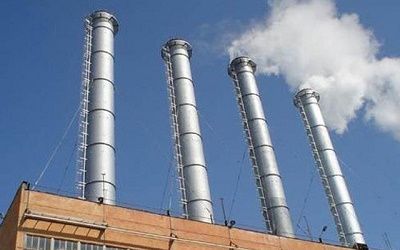

Communal boiler plant A communal boiler plant is a small boiler plant, ideal for heating one or more apartment buildings. offers block-modular models of full factory readiness!
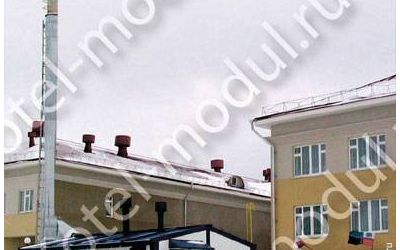

Commissioning a boiler house for industrial operation In the sphere of boiler house construction services, the term "turnkey" is quite common, but most often - without any specifics. Having not received a clear definition, the meaning of this term varies from company to company, which naturally causes certain differences in understanding.
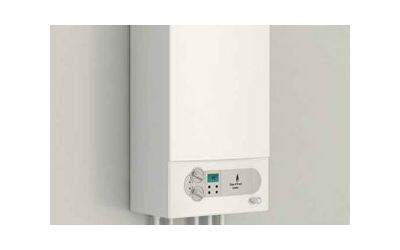

Industrial heating boiler house Industrial heating boiler plants are called, which work not only for production needs (heat, steam and hot water for technological needs), but also for heating by heating residential, household, social and administrative buildings that are part of the infrastructure of the enterprise.
Gas cylinders in winter
If the gas cylinders are outside the house, then in winter at negative temperatures the pressure of the liquefied gas decreases, and the boiler may simply turn off. To prevent this from happening, the cylinders are installed in a special cabinet with good ventilation, insulated with non-combustible materials. Separate non-residential buildings with minimal heating are also suitable for this purpose. When using cylinders, you should observe safety measures:
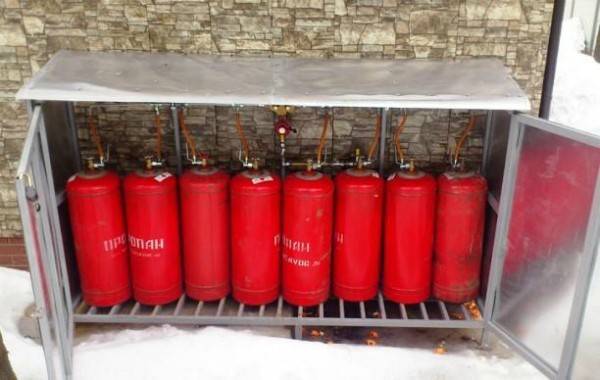

Special locker for the installation of cylinders
- It is forbidden to heat containers with gas using an open flame;
- There should not be a basement or a cellar near the cylinders, since liquefied gas, when leaking, goes down, has no smell and can accumulate to an explosive concentration;
- It is advisable to install a gas leakage sensor;
- Warehousing of full containers is allowed at a distance of 10 m from the living quarters;
- Storing empty cylinders in the house is prohibited;
- Once every 4 years, it is necessary to check the cylinders for integrity and tightness.
What is natural gas and how is it transported through a gas pipeline
Natural gas is extracted from underground. Its chemical composition differs in different deposits. This combustible mixture is 80% methane. It is odorless, odoriferous impurities, odorons, are added to detect a leak in the gas mixture.
From the place of extraction, methane is supplied through pipes. The line pressure reaches 12 MPa. It enters the domestic gas pipeline system through a distribution station, where the gas is cleaned of impurities and the compression is reduced to 1.2 MPa. Another point on the way of movement is the gas regulator. Here the pressure in the gas pipeline is regulated, the mixture is additionally purified and distributed to consumers.
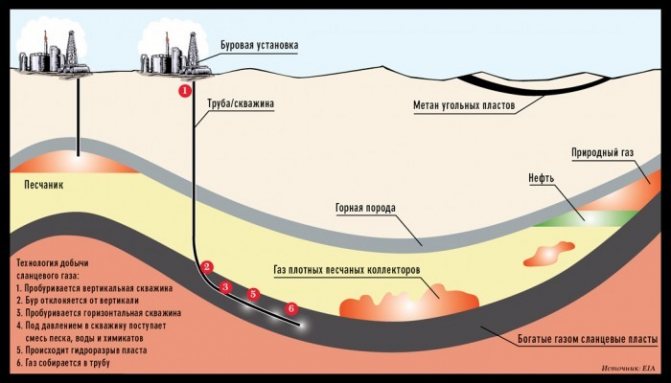

How to convert a heating boiler to liquefied gas
- It is necessary to change the feed rate of the gas-air mixture.
- You will need to install a LPG jet kit.
- Adjust the automation for other operating parameters.
In the technical documentation of the heating equipment, the minimum pressure at which the burner continues to work is indicated. The lower this indicator, the more propane-butane mixture, it will be possible to use from the filled fuel tank. Usually, 15-30% of the total volume remains in the container.
LPG boiler nozzles
- The difference between LPG and main gas nozzles lies in the different outlet diameters. Typically, the propane / butane jets are narrower.
- After installing a set of nozzles for converting the heating boiler from natural gas to liquefied gas, the pressure in the system increases slightly.
- The reduced diameter of the nozzle leads to a decrease in the feed rate of the gas-air propane-butane mixture. For normal operation of a 10 kW unit, it is required that the head is no more than 0.86 kg / h.
Which gas is more profitable to heat - natural or liquefied
- Changes in construction and reconfiguration of the boiler when using liquefied gas are temporary. It can take about six months from the beginning of registration and ordering a project for the installation of heating equipment connected to the main gas pipeline. During this period, it is economically impractical to heat the room with electric or solid fuel heating equipment specially purchased for this purpose. The cost of converting a conventional boiler to liquefied gas ranges from 500-1000 rubles.
- Connecting a gas tank - in this case, the cost of using the mixture is more profitable than heating with wood, electricity or diesel fuel. The only condition is that a qualified specialist is reported to adjust the pressure of liquefied gas, adjust the operation of the automation. Incorrect settings will increase the flow rate by approximately 15%.
Differences between boilers on a gas pipeline and on liquefied gas
Despite the use of one natural resource, boilers for liquefied gas are very different from boilers on a gas pipeline:
- To convert fuel into a gaseous state, it is necessary to install special equipment (reducer), when gas is supplied directly from the mainline, this is not required.
- High efficiency. The efficiency of liquefied gas reaches 95-98%. Manufacturers monitor this indicator and try to increase it, since this fuel is not the cheapest, and it is necessary to use its potential to the maximum.
- Injectors.
- Lower pressure is the key difference between a LPG boiler and a gas boiler.
Calculation method for natural gas
The approximate gas consumption for heating is calculated based on the half capacity of the installed boiler. The thing is that when determining the power of a gas boiler, the lowest temperature is set.This is understandable - even when it is very cold outside, the house should be warm.


You can calculate the gas consumption for heating yourself
But it is completely wrong to count gas consumption for heating at this maximum figure - after all, in general, the temperature is much higher, which means that much less fuel is burned. Therefore, it is customary to consider the average fuel consumption for heating - about 50% of the heat loss or boiler power.
We calculate the gas consumption by heat loss
If there is no boiler yet, and you estimate the cost of heating in different ways, you can count from the total heat loss of the building. They are most likely known to you. The technique here is as follows: take 50% of the total heat loss, add 10% to provide hot water supply and 10% to heat outflow during ventilation. As a result, we get the average consumption in kilowatts per hour.
Next, you can find out the fuel consumption per day (multiplied by 24 hours), per month (by 30 days), if desired, for the entire heating season (multiplied by the number of months during which the heating works). All these figures can be converted into cubic meters (knowing the specific heat of combustion of gas), and then multiply cubic meters by the price of gas and, thus, find out the cost of heating.
Specific heat of combustion in kcal
Example of calculation for heat loss
Let the heat loss at home be 16 kW / h. Let's start counting:
- average heat demand per hour - 8 kW / h + 1.6 kW / h + 1.6 kW / h = 11.2 kW / h;
- per day - 11.2 kW * 24 hours = 268.8 kW;
- per month - 268.8 kW * 30 days = 8064 kW.
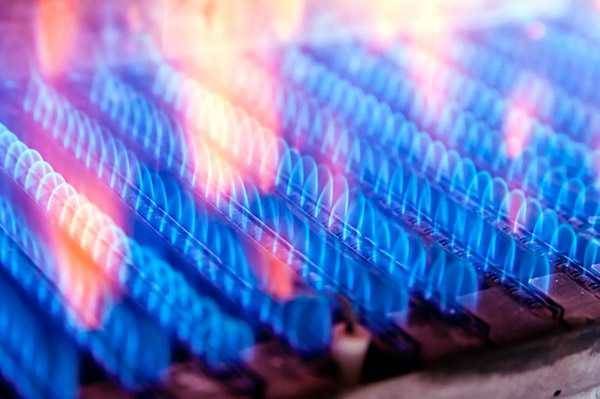

The actual gas consumption for heating also depends on the type of burner - modulating the most economical
We translate into cubic meters. If we use natural gas, we divide the gas consumption for heating per hour: 11.2 kW / h / 9.3 kW = 1.2 m3 / h. In the calculations, the figure of 9.3 kW is the specific heat capacity of natural gas combustion (available in the table).
By the way, you can also calculate the required amount of fuel of any type - you just need to take the heat capacity for the required fuel.
Since the boiler has not 100% efficiency, but 88-92%, you will have to make more adjustments for this - add about 10% of the figure obtained. In total, we get the gas consumption for heating per hour - 1.32 cubic meters per hour. Then you can calculate:
- flow rate per day: 1.32 m3 * 24 hours = 28.8 m3 / day
- demand per month: 28.8 m3 / day * 30 days = 864 m3 / month.
The average consumption for the heating season depends on its duration - we multiply it by the number of months while the heating season lasts.
This calculation is approximate. In some month, gas consumption will be much less, in the coldest month - more, but on average the figure will be about the same.
Boiler power calculation
The calculations will be a little easier if there is a calculated boiler power - all the necessary reserves have already been taken into account (for hot water supply and ventilation). Therefore, we simply take 50% of the design capacity and then calculate the consumption per day, month, per season.
For example, the design capacity of the boiler is 24 kW. To calculate the gas consumption for heating, we take half: 12 K / W. This will be the average heat demand per hour. To determine the fuel consumption per hour, we divide by the calorific value, we get 12 kW / h / 9.3 kW / W = 1.3 m3. Further, everything is considered as in the example above:
- per day: 12 kW / h * 24 hours = 288 kW in terms of the amount of gas - 1.3 m3 * 24 = 31.2 m3
- per month: 288 kW * 30 days = 8640 m3, consumption in cubic meters 31.2 m3 * 30 = 936 m3.
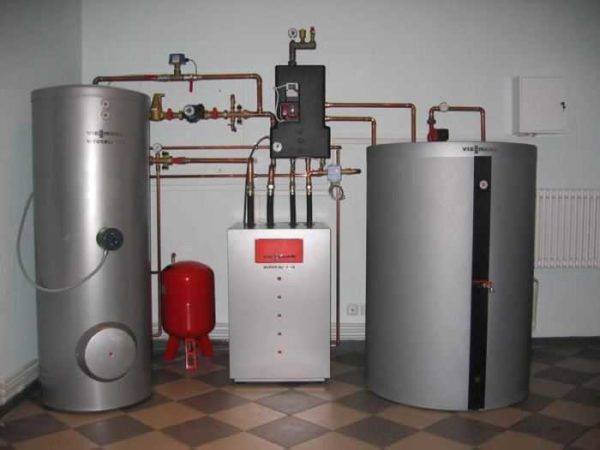

You can calculate the gas consumption for heating a house according to the design capacity of the boiler.
Next, add 10% to the imperfection of the boiler, we get that for this case the consumption will be slightly more than 1000 cubic meters per month (1029.3 cubic meters). As you can see, in this case everything is even simpler - fewer numbers, but the principle is the same.
Natural gas and its circulation through a gas pipeline
Gas is called natural conventionally, it is mined underground and supplied to users in the form of heat. The composition of the combustible mixture can be varied, but most of all there is methane in it, from 80 percent. Methane is the main element of the composition, and the rest of the substances are considered polluting waste, they contribute to the destruction of pipes.
Naturally occurring gas is odorless so that a leak can be detected. Various impurities, odorons, are added to it. Before the gas enters the dwelling, it passes through the gas system; the main path it makes is along the gas pipeline.There is too much pressure in the main line of 11.8 MPa, this figure is not suitable for consumption by ordinary houses. The pressure is reduced in special gas distribution stations and then supplied to users. At the same time, the pressure drops to 1.2 MPa. In addition, the gas is cleaned at the station and enriched with an odor so that a leak can be detected during its operation. From the distribution station, gas flows to the points of the gas regulator, which distribute it to consumers. Such points are able to control pressure, and determine the degree of its decrease or increase. Also, at these points, the gas is filtered again, and special devices show its impurities.
Choosing a liquefied gas boiler
An important criterion is power, measured in kW. The heated area, as a rule, is 9-10 times larger than this value. That is, choosing a boiler with a capacity of 11.3 kW, you will heat a room with an area of about 100 m2.
However, it is necessary to make an allowance for the fact that with prolonged and severe frosts, equipment of such power will not be able to maintain the set temperature. Therefore, experts recommend choosing a boiler unit with a margin.
Other parameters:
- Boiler type. By the method of installation, wall and floor models are distinguished, by functionality - single and double-circuit (heat + hot water), with an open or closed combustion chamber.
- Efficiency. The higher the indicator, the more economical and efficient the installation will be. The parameter ranges from 90-94%.
- Pressure. The LPG unit must operate at low pressure (3-5 mbar). A low value will ensure the production of gas from the cylinders without residue.
- Gas consumption. The figures indicated by the manufacturer are arbitrary and depend on the power and efficiency of the unit, the set temperature in the room and outside the window, the heat loss of the building and other factors.
When planning the construction of a house, attention should also be paid to the heating system project. The correct solution is to delegate the task to experienced designers who:
The correct solution is to delegate the task to experienced designers who
:
- calculate the amount of heat load;
- will develop recommendations regarding the choice of heating equipment and related materials.
Knowing the necessary parameters of the boiler, it remains to choose a device in terms of appearance and price. Russian boilers are the cheapest. Popular Japanese-made models cost twice as much. And the "Germans" will cost even more.
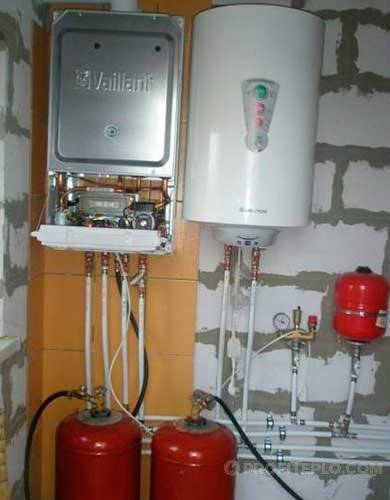

LPG boiler
Gas boilers
A boiler that receives gas from the mains is currently the most economical option for a home.
Natural gas
The mixture of gases produced in nature is called natural gas. The main element is methane (about 98%), additional elements: carbon dioxide, nitrogen, saturated hydrocarbons (propane, butane, ethane).
These components are divided into flammable and non-flammable. Combustible:
- Methane (non-toxic gas, colorless and odorless).
- Hydrogen (non-toxic gas, its mixtures are explosive).
Non-flammable:
- Nitrogen.
- Oxygen.
- Carbon dioxide.
All components of such a gas are colorless and odorless, therefore, in order to quickly detect and eliminate leaks, they give the gas a special smell before being fed into the pipes. Thanks to this, even small amounts of gas can be quickly detected.
Gas pressure in the main
If you decide to buy a boiler from a foreign manufacturer, you should pay attention to the possibility of working with a Russian network. Indeed, in our gas pipelines the fuel pressure is much lower than in other countries.
Important conditions in this case: nominal and minimum pressure.
The nominal value is the value at which the boiler will produce the power set by the plant.
Minimum - the lower limit, if the pressure drops below, the boiler will stop functioning.
Moreover, in European countries the nominal value in the highway is 20mbar, in Russia - 13-17mbar.Manufacturers are trying to produce the most versatile boilers, however, there is an average value of the nominal and minimum value of this parameter, depending on the type of unit:
- Wall mounted boilers. The nominal value is 13mbar, the minimum is 4.5mbar.
- Floor standing boilers. Nominal - 18mbar, the minimum depends on the individual settings of the unit.
- Floor standing with atmospheric burner. Nominal - 15mbar, minimum - 5mbar.
These numbers are optional, it all depends on the manufacturer. For an accurate selection of equipment, it is better to seek professional help. After all, having made the wrong choice, you can choose a boiler that, for example, will produce the required amount of energy, but will not work at full strength. Therefore, such a purchase will not be justified.
Advantages of boilers on a gas pipeline
This type of heating equipment has become widely known in Russia due to several advantages:
- Security. Despite the fact that gas is an explosive fuel, its use in modern boilers is not associated with any risks, thanks to a modern automation system that stops the operation of the unit in case of any failures.
- Cost. Gas is the cheapest fuel in Russia, so it has no equal in operating costs. Connecting a gas pipeline is, of course, a costly process, but all costs are quickly paid off.
- Silence.
- Ease of use. The process is automated, so human intervention is minimized.
Disadvantages of boilers on the gas pipeline
Despite the widespread use of this type of fuel in our country, boilers on the gas pipeline have significant drawbacks:
- Complexity of installation. It is not enough to select and connect a boiler, it is necessary to develop project documentation for connecting to the mains (this must be done by an accredited company). In addition, the installation of this unit is a responsible business, therefore it must be carried out by professionals, which increases the cost of installation work.
- Not always stable operation of the gas network. Pressure surges are possible, which can lead to a shutdown of heating in your home and rapid deterioration of equipment.
In cases where these shortcomings are critical, or it is not possible to lead a gas pipeline to the house, an excellent solution is to install a liquefied gas boiler.
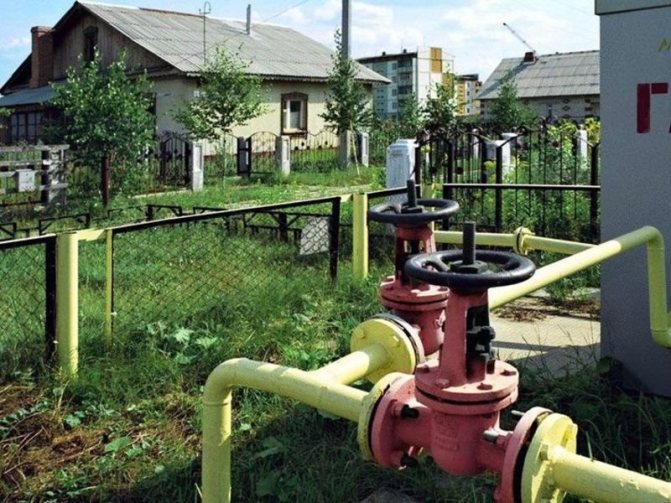

What volume to choose a gas cylinder
| Weight and internal volume of gas cylinders | ||||
| Volume (l) | 5 | 12 | 27 | 50 |
| Empty tank weight (kg) | 4 | 5,5 | 14,5 | 22,0 |
| Propane cylinder weight (kg) | 6 | 11 | 25,9 | 43,2 |
| Gas weight (kg) | 2 | 5,5 | 11,4 | 21,2 |
| Cylinder height (mm) | 290 | 500 | 600 | 930 |
| Balloon diameter (mm) | 200 | 230 | 299 | 299 |
| The volume of gas in the cylinder, depending on the capacity | ||||
| Tank capacity (l) | 5 | 12 | 27 | 50 |
| Gas capacity (m³) | 0,95 | 2,59 | 5,38 | 10,01 |
| Volume of liquid propane (l) | 4,3 | 10,2 | 22,9 | 42,5 |
How to connect a column to a gas cylinder
- cylinders are connected through the ramp, several from 2-4 pcs .;
- an adjustable reducer is installed to normalize the pressure.
Differences between liquefied gas and natural gas
Liquefied gas has advantages and disadvantages over natural gas. Namely:
- Natural gas is much cheaper than liquefied gas.
- LPG (liquefied petroleum gases) has a higher calorific value than natural gas.
- Liquefied gas has less propane decay, which has a positive effect on the safety of your home.
Evaluate these positive and negative features of using liquefied fuel and draw a conclusion or call us, and we will help you make the right decision for the comfort in your home.
How preparation for the first launch should be done
Before turning on the gas boiler, it is imperative to carry out preparatory work. For this:
- Fully mount the equipment, complete the piping and ensure correct installation.
- Do not neglect fire safety rules. Install all fasteners according to them.
- Leave a small space between the boiler and the wall. This distance should be indicated in the instructions.It is not recommended to install equipment near a window.
- Move all flammable objects away from you.
- Attach the boiler drum straight, without distortion.
- Connect it to a cold plumbing system by removing the plugs on the pipes. At the inlet, mount the filter on which the ball valve is located. In this way, the system will be protected from contamination that can lead to breakdowns. A ball valve must be installed on each piping.
- Install the gas pipes carefully.
- Move the outlet closer to the heating equipment. Remember that the boiler must be operated from a separate power line. In some cases, it is allowed to connect equipment to a gas generator for the purpose of its autonomous operation.
- Connect the chimney and check its draft.
- Fill the boiler with cold water with the power off. The primary kit will help eliminate the presence of leaks.
- Turn the thermostat to maximum.
Types of gases for home heating
There are three types of gases for heating a house:
- Natural methane (G20).
- Liquid butane (G30).
- Liquid propane (G31).
The heater's official document states which gas is intended for this model. The main role in the transfer of a heating boiler from one type of gas to another is played by the replacement of nozzles. The next step is the installation of a new kit designed for liquefied fuel in place of the old one. Further, the setting of various functioning items of boiler devices takes place.
Entrust this difficult and responsible work to our experienced craftsmen, and you will not regret it. Fill out the form and expect a call from our manager.
The best manufacturers and models: characteristics and prices
The country of manufacture determines the functionality and quality of the unit: given that it is purchased for many years to come, you should not exchange for dubious equipment offered by the Chinese market. It is better to opt for proven options from European or Russian manufacturers.
Protherm Gepard 23 MOV
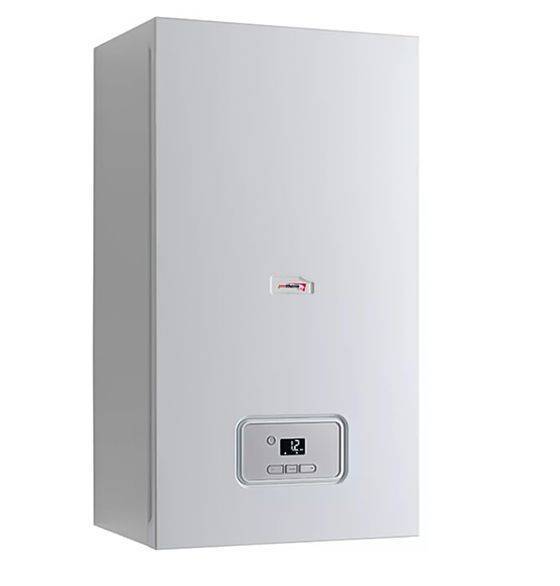

The well-known two-circuit mounted model with a power of 23 kW. It has an open combustion chamber (natural draft) and a copper plate heat exchanger: more heat conductive and resistant to corrosion. Excellent, considering the price category, the automation allows you to fine-tune the operation of the boiler and efficiently consume fuel (max 1.9 l / h).
Cost: 39 870 - 42 480 rubles.
Manufacturer: Protherm (Proterm), Slovakia.
Bosch Gaz WBN6000-24C RN S5700
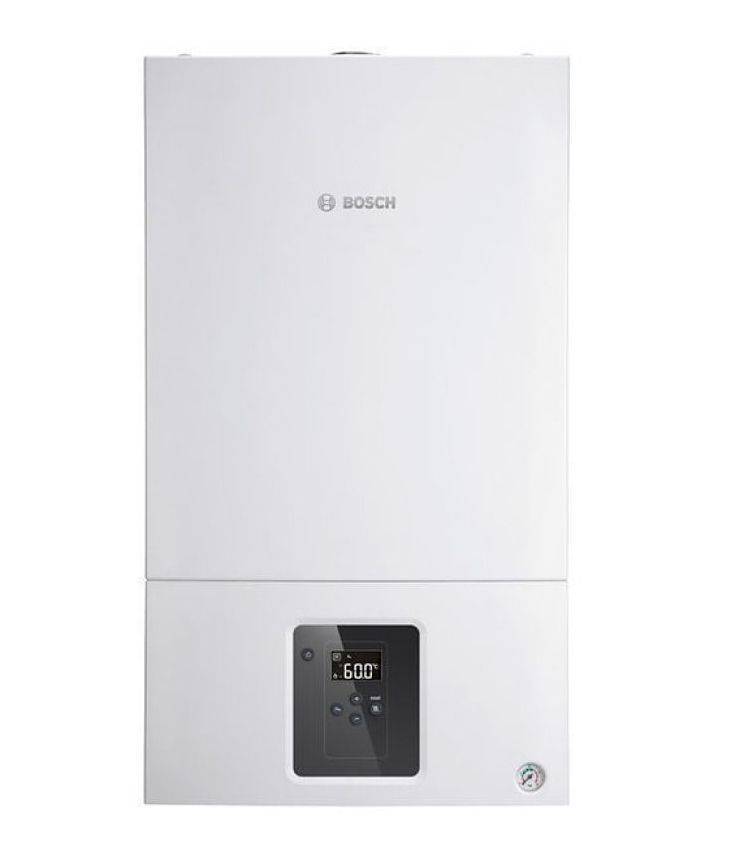

The German BOSCH with a capacity of 24 kW is made of better materials, is not picky about the quality of fuel and coolant. It is fully adapted to Russian conditions: it is resistant to voltage drops, pressure drops and sudden cold snaps (up to -35 ° C). Economical gas consumption (max 1.5 l / h) is ensured by a modulating fan, a three-speed pump, as well as thermal insulation of the casing.
Cost: 36,900 - 38,460 rubles.
Manufacturer: Bosch Thermotechnik (Bosch Thermotechnik), Germany-Russia.
Buderus Logamax U072-18K


We can say that this inexpensive single-circuit boiler is one of the best gas boilers for liquefied gas for heating a private house: with a power of 18 kW, it consumes fuel very moderately (max 1.5 l / h). A built-in diaphragm expansion tank and a three-way valve make it easy to transfer it to DHW. At the same time, the model is known for high reliability, the nature
Cost: 26,200–31,840 rubles.
Manufacturer: Buderus (Buderus), Germany-Russia.
BAXI SLIM 1.150 I
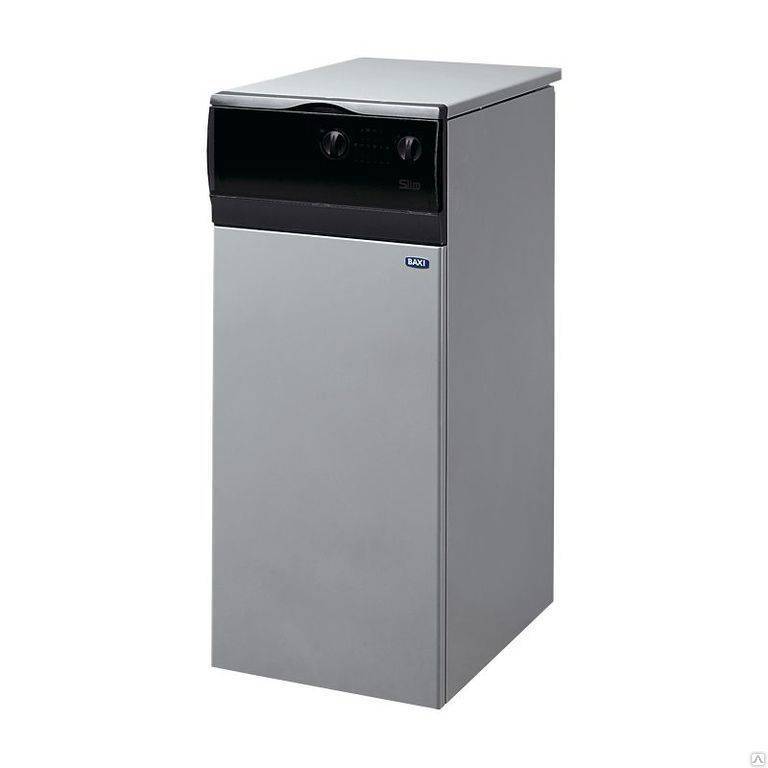

The famous Italian floor-standing boiler of low power (15 kW) is known for the minimum gas consumption (max 1.1 l / h). From the factory, it is equipped with weather-dependent automation, a cast iron heat exchanger and a control module with an integrated self-diagnosis option. And another important plus is its modest dimensions: for example, its width is only 35 cm.
Cost: 62,090 - 71,300 rubles.
Manufacturer: Baxi, Italy.
Wester Lemax Clever-30
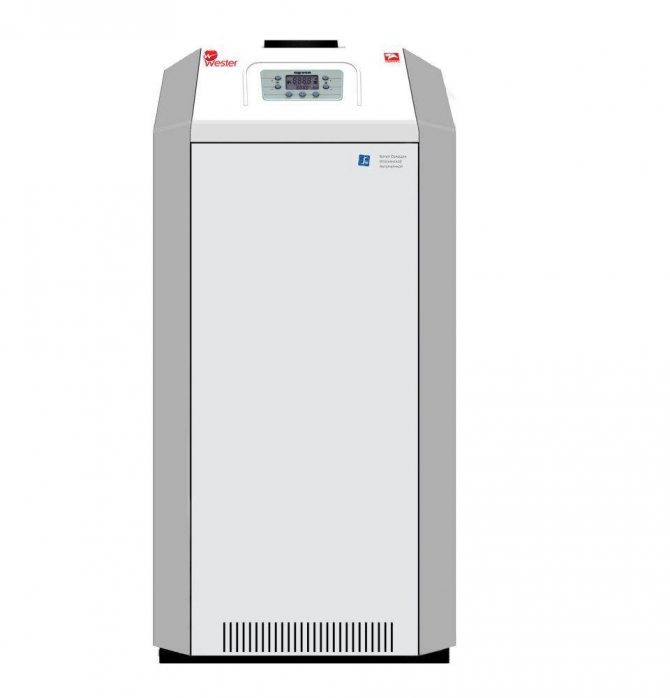

Domestic single-circuit wall-mounted device with a power of 30 kW, which does not depend on the availability of electricity. It can work in a system with both forced and natural circulation of the coolant, and continuous smooth flame modulation from 30% to 100% can significantly reduce the volume of fuel consumption (max 1.7 l / h). With such a high efficiency, it also differs in reliability close to European manufacturers.
The only significant drawback is the steel heat exchanger, which is characterized by a limited resource (10-14 years).
Cost: 34 250 - 40 500 rubles.
Manufacturer: Lemax (Lemax), Russia.
Boiler room equipment
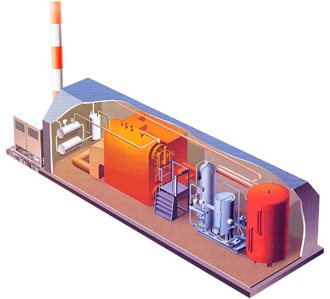

A liquefied gas boiler, in terms of system and technical characteristics, practically does not differ from a conventional gas unit. The only difference is that special nozzles of a smaller diameter are used, which are designed for a certain gas pressure. Often, these nozzles are included with the main equipment, but sometimes they have to be purchased additionally.
The complete set of a boiler room for liquefied gas and an ordinary boiler room is literally no different. When the boiler operates on liquefied gas, the fuel is served through the pipeline from the gas holder to the unit.
The operation of the equipment is regulated by automatic equipment and in the event of malfunctions, it stops. The system does not need constant monitoring of the operating personnel and works almost autonomously.
Choosing a storage location for gas cylinders
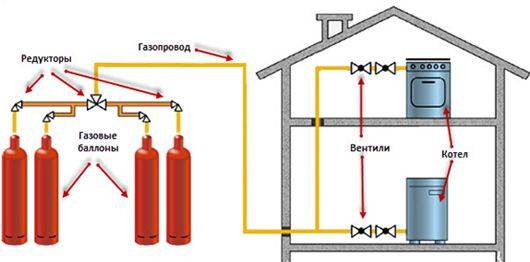

Cylinder connection diagram
Before deciding on the method of storing gas cylinders, it is necessary to correctly select their capacity. Currently, you can use containers with a capacity of 5, 12, 27 and 50 liters. If the heating of a private house with bottled gas is regular, it is best to purchase containers with a maximum volume of 50 liters.
To supply gas, a pipeline is made from the storage area of the cylinders to the boiler. You can use several containers at once by installing on each gas reducer. It should include two pressure gauges. One of them is needed to verify the pressure reading inside the cylinder, and the second shows this value at the outlet. The shut-off valve is used to regulate the flow rate of the fuel.


Reducer for cylinders
The place of choice for their storage directly depends on how many cylinders are needed for the heating boiler. The estimated number of containers depends on the following indicators:
- The total area of the house;
- Heat loss in the building;
- Minimum temperature in winter.
An important point is the place where the gas cylinder heating boiler will be installed. The length of the supply line should be minimal in order to reduce the likelihood of its depressurization and to optimize the gas consumption.
Separate room for cylinders


Storing gas cylinders at home
The best way to store gas cylinders for heating is to prepare a separate room. The rules for the arrangement and the requirements for it are described in detail in SNiP 2.04.08-87. Therefore, before installing heating using gas cylinders, it is necessary to familiarize yourself with this document.
The best option if the storage room will be located in the immediate vicinity of the boiler installation site. In this way, the supply line can be kept as short as possible. It is also necessary to provide the following storage conditions for containers for heating a private house from gas cylinders with your own hands:
- The room should not store flammable or lubricants;
- It is forbidden to use any heating devices - convectors, heaters. The exception is water heating pipes and radiators;
- Supply ventilation. Average air exchange rate is 12 m³ / hour per 1 m² of the room;
- Each cylinder must be placed on a pallet. This is necessary to maintain stability against possible fluctuations in the capacity during the gas release.
To ensure safety, the room must be closed. Fuel for heating a private house with bottled gas is supplied through the mains. If flexible hoses are used for this, during installation it is necessary to avoid kinking them.
Gas cylinder storage cabinet requirements
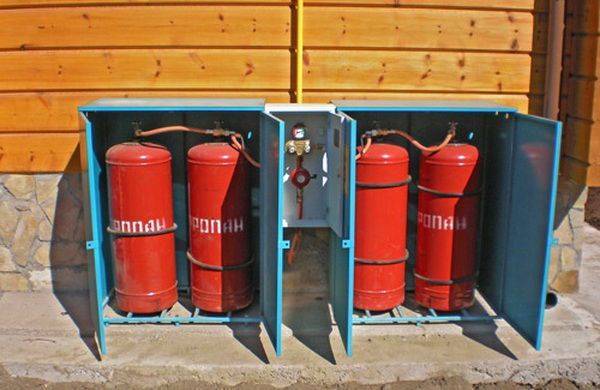

Storage of cylinders in cabinets
An alternative to the above method is the use of special metal cabinets. This is important for heating a summer house with gas cylinders with low fuel consumption.
It is recommended to purchase a ready-made structure, since it will take into account the requirements from GOST 15860-84. They are as follows:
- Airing. To do this, there must be ventilation holes in the cabinet structure;
- Eliminate the possibility of sunlight hitting gas cylinders. This can lead to a rise in temperature on their surface;
- All elements of individual heating from gas cylinders must be made of non-combustible materials. The same applies to storage cabinets;
- Availability of warning signs and inscriptions.
How long is a 50 liter gas cylinder for heating? It all depends on the nominal consumption of the boiler. But, despite this, only two cylinders can be stored in one cabinet. The optimal dimensions of the structure in this case will be 2000 * 1000 * 570. A separate foundation must be made before installing the cabinet. Its dimensions should exceed the dimensions of the structure by 15-20 cm.
The installation rules for heating a private house from gas cylinders with their own hands are also respected:
- The minimum distance from doors and windows should be 5 m;
- The wall to which the cabinet will adjoin is made of non-combustible materials.
Be sure to make special ventilation gaps on the surface of the foundation. Experts recommend grounding the structure to remove possible static voltage.
Gas pressure in the gas pipeline at home
A gas pipeline is the movement of gas through pipes from the place of its storage to the user. Gas pipelines can be surface, underground, inundated or underwater. The gas pipeline is subdivided into different categories, which are determined by the gas pressure. To provide settlements and cities, the pressure can be low up to 0.05 kgf / cm2, medium - up to 3 kgf / cm2, or high up to 6 kgf / cm2. A very high indicator is considered up to 12 kgf / cm2. The pressure level depends on the purpose of this section of the gas pipeline, the highest pressure is in the main pipeline, and the lowest is inside the dwelling. There is a special GOST for the gas pipeline, which must be met. High pressure areas are intended for industrial enterprises or gas supply between cities. Low or medium pressure is intended for an ordinary user, usually 0.05 kgf / cm2 is supplied to a residential building.
Calculation of costs for the device of autonomous gas heating
Comparing which of the types of heating systems will be the least expensive, you first need to pay attention to the consumption of liquefied gas for heating. It is advisable to compare the upcoming costs with similar costs for other types of fuel and decide which option will be more profitable.
Initial costs for equipment and furnishings
The cost of purchasing equipment and installing an autonomous heating system on liquefied gas in your home may vary slightly in different regions of residence. But in general, when compared with the connection to the main gas pipeline, the difference in cost will be insignificant. It will be more expensive only if you use not cylinders, but a gas holder with a volume of several cubes. Its cost will be more than 300,000 rubles.
Also, the cost of equipping rooms for boilers using LPG is almost equal in cost compared to those that run on diesel fuel.As evidenced by reviews, heating with liquefied gas only requires higher initial costs when it serves as an alternative to solid fuel or electric heating. But in the course of further operation, the funds invested in heating a private house with liquefied gas will gradually pay off due to the profitability of this type of fuel.
Output
For heating a private house, the ideal option is to install a boiler on a gas pipeline. But in some cases (for example, when you are rarely at the dacha in winter, or when the main gas pipeline is only planned), such work is not carried out, since it takes a lot of time and money, or is not yet possible. An excellent alternative is the purchase of a liquefied gas boiler. The main thing is to correctly calculate the required power and carry out the installation in accordance with all standards. Then you will not have problems with leaks, and the comfortable microclimate in the house will be uninterrupted.
28.06.2017
Back to the list
Reasons for using liquefied gas to heat your home
Liquefied gas is gaining more and more popularity among residents of private houses, country cottages and summer cottages. Its use has advantages over other heating methods:
- Lower pressure compared to main gas (no more than 3-4 mbar).
- High efficiency - 92-95%.
- It is versatile, so if you change your mind, you can reconfigure to the main pipeline.
You can call a specialist to solve your problem. Fill out the form, briefly describe your problem and we will call you back for consultation.
Free consultation
Classification
Liquefied gas boilers are single-circuit and double-circuit. A single-circuit boiler is intended only for heating, while a double-circuit boiler is capable of both heating the house and providing hot water in it.
Consumers are offered wall-mounted, with open and closed combustion chambers. In addition, you should pay attention to the power of this heater. The variety of modifications often makes it difficult for the user to choose, so it's worth dwelling in more detail on the most important characteristics.
For boilers operating on liquefied gas, the ability to operate at low pressure is of fundamental importance.
The continuous supply of bottled gas will be carried out at a pressure of 3-4 Mbar. Therefore, when you should pay attention to this parameter.
